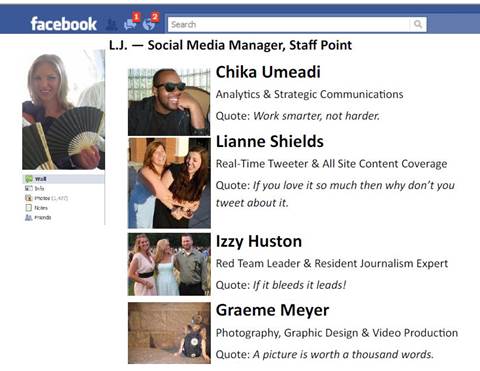The Need for Speed
Social media has changed not only the way
people interact, but also the speed at which customers expect problems to be
solved. “Prior to social media, people wrote snail-mail letters if they had a
problem,” says Leslie Youngdahl, social media analyst at Consumers Energy’s
digital care team in Lansing, Mich. “Now, through social media, they expect an
immediate response.”
Like other utilities, Consumers Energy is
regulated by various state agencies, the Federal Energy Regulatory Commission
and other entities. The company has a digital team made up of Youngdahl and two
other employees who strive to acknowledge customers’ remarks within an hour.
They do this via a special email account that each team member can access.
The team members also post content on social
networks, and when they discover a customer concern, they notify people in the
company who can address the matter. “Even if it’s two or three people talking
about a subject, we always forward it to the appropriate people,” says
Youngdahl.

The
team members also post content on social networks, and when they discover a
customer concern, they notify people in the company who can address the matter.
A recent social media conversation, for
instance, alerted the digital team to a problem with the wording on the
company’s website that made it difficult for customers to log in. Youngdahl
relayed the posts to the company’s Web team and IT department and showed them a
report on the trending topic and related keywords. The Web and IT teams then
made the necessary changes.
“The conversation on that topic died down
within a week after we made the change,” says Youngdahl.
Consumers Energy primarily uses social
media for customer service and to post updates about outages during storms. But
as it reaches out to customers via social media, the company must ensure that
it protects their privacy. For example, says Youngdahl, a customer might reveal
his account number during an online conversation. When that happens, she says,
“we delete it immediately and take the conversation offline.”
Healthcare: Patient Privacy First
“As a healthcare service, our No. 1 concern
is protecting our patients,” says Susan Solomon, vice president of marketing
and public relations at St. Joseph Health, a 14-hospital healthcare provider
serving California, West Texas and Eastern New Mexico. “It’s mainly about
privacy issues, but there absolutely are ways to stay within the regulations
and make social media work. You simply have to set boundaries up front.”
St. Joseph’s social media goals include reaching
out to people to carry on conversations about their health long after they’ve
left the hospital, Solomon says. For example, the subject of a recent St.
Joseph Facebook post was, “How do you use super foods?”
The organization also uses Facebook and Twitter
to drive users to a landing page where they can sign up for a newsletter, make
an appointment 01* otherwise securely interact with hospital staffers. For
example, a recent breast health campaign included posts on the hospital’s
Facebook timeline that directed women to a landing page where they could
schedule a mammogram.

The
organization also uses Facebook and Twitter to drive users to a landing page
where they can sign up for a newsletter, make an appointment 01* otherwise
securely interact with hospital staffers
Physicians also use social media to relay
credible information to patients who may be searching the Internet for medical
information only to find bad advice from unreliable sources.
That’s why Boston Children’s Hospital makes
sure all of its 60,000 pages of online content goes through a peer-review
process, says Margaret Coughlin, senior vice president and chief marketing and
communications officer at Boston Children’s.
With over 741,000 likes, Boston Children’s
has the second-highest number of Facebook followers of any children’s hospital
St. Jude Children’s Research Hospital in Memphis is No. 1.
Coughlin says Boston Children’s “got ahead
of the curve” by studying the way people choose hospitals and doctors. This
involved developing a proprietary model based on primary and secondary research
of patients and non-patients to see how many social media sources they and
their families and friends turned to when researching illnesses and healthcare
facilities.

With
over 741,000 likes, Boston Children’s has the second-highest number of Facebook
The hospital also tracked how people
interacted with these information sources. “We wanted to know where and how
patients were getting their information and the likelihood of them going back
to a certain social media site for information,” says Coughlin.
It became clear that word of mouth and
references from friends and relatives were most important to consumers. “Social
networking gives word of mouth a whole new meaning, as those friends could
include their online friends as well,” Coughlin says.
The research also yielded a surprise.
Whether a child had cancer or hip pain, the number of sources searched was not
that different, says Coughlin. “This made us realize we needed to expand the
information we provide to patients in as many social media platforms as
possible.” Interestingly, some patients aren’t concerned with their own
privacy. “We have patients who want their lab test results via Twitter, which
isn’t appropriate,” Coughlin says, “but it tells us that people are interested
in fast information.” In response, the hospital created a secure portal called
MyChildren, where patients can get their lab results and other information.
As for employee social networking rules, no
one outside of Coughlin’s department is allowed to blog as a representative of
Boston Children’s Hospital. And no employees can dispense medical advice via
social media, although general information and links to helpful sites is fine.
When social media first came on the scene,
some executives at companies in regulated industries resisted, in what
Prescient s Ward calls a knee-jerk reaction to new technology. But with a few
precautions, these companies can engage, connect and converse with customers as
effectively as organizations in any other sector.